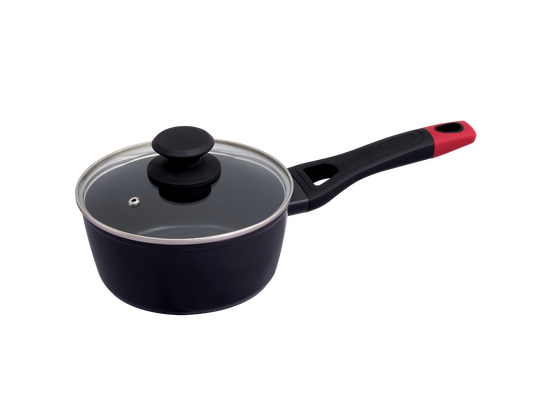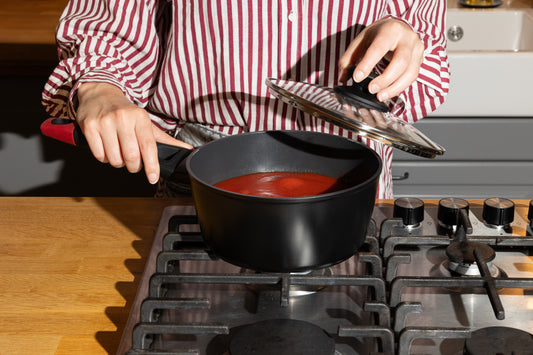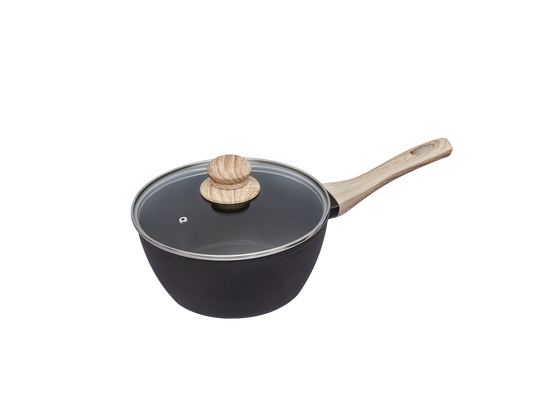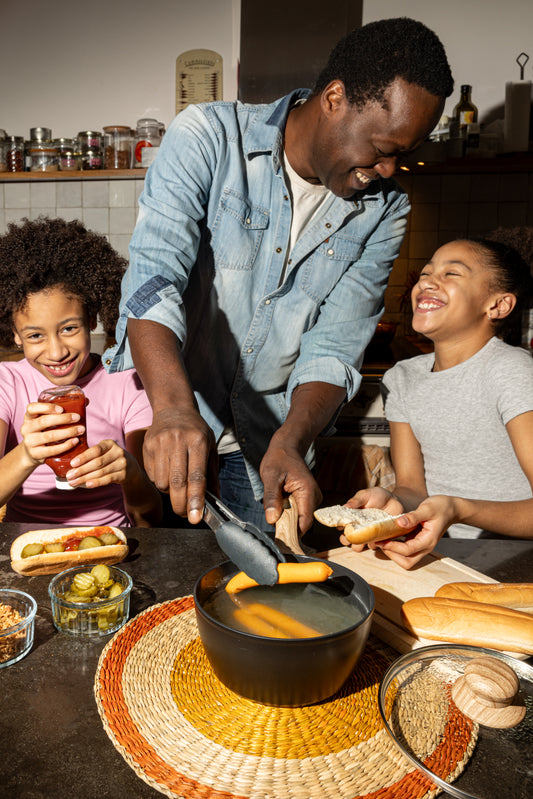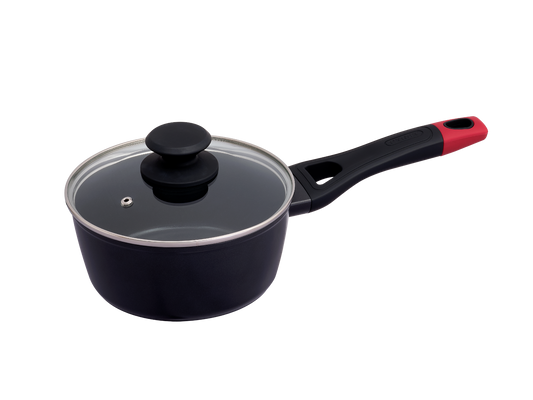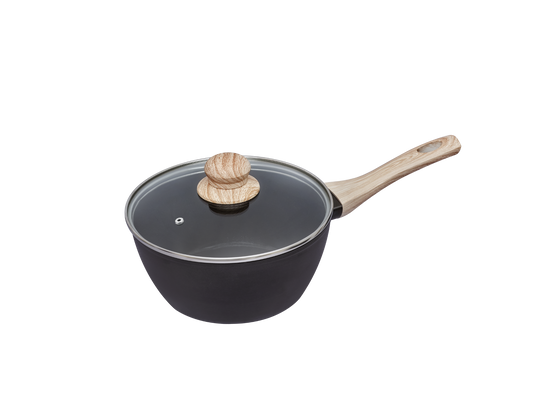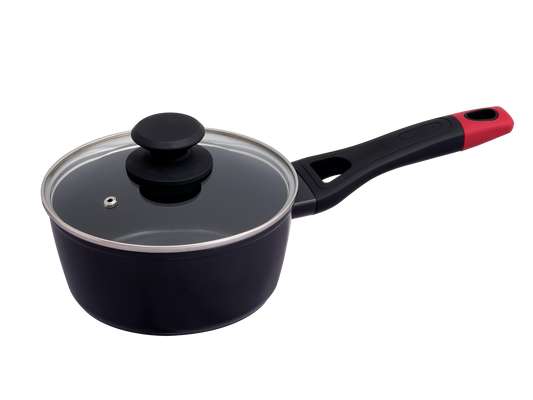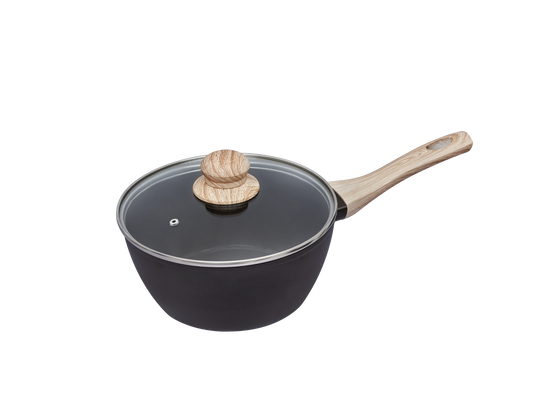Saucepans
Everything you need to know about Pyrex® saucepans: use, care, and all-hob compatibility
The Pyrex® range of PFAS-free non-stick saucepans, easy to use and clean, comes in several sizes. To help you choose the right Pyrex® saucepan, find the model best suited to boiling, simmering, reheating, or preparing creams and sauces.
Pyrex® saucepan: an essential kitchen tool
A saucepan is one of the most essential pieces of cookware in your kitchen. Versatile, it is just as useful for preparing savoury as it is for sweet dishes. Perfect for cooking pasta, rice, or potatoes, it is also indispensable for making sauces, desserts, and caramels. With its matching lid, it allows you to simmer gently and becomes a true kitchen staple.
How to choose your Pyrex® saucepan?
We take into account all your cooking needs. That’s why our range of saucepans is the best way to equip your kitchen for the long term, with a choice of PFAS-free non-stick coatings that let you cook anything without worrying about food sticking to the bottom.
Pyrex® has designed a collection of saucepans from 16 to 20 cm in diameter, each supplied with its perfectly fitting lid. Handle design is just as important, which is why every Pyrex® saucepan comes with an ergonomic, ultra-comfortable handle and a velvet-touch finish for a secure, easy grip, paired with its matching lid.
Why choose a PFAS-free non-stick Pyrex® saucepan?
Founded in 1915, the story of Pyrex® is remarkable. The brand became a pioneer in creating borosilicate glass dishes, renowned for their heat resistance. Today, the Pyrex® cookware collection includes not only saucepans, frying pans, stew pots, woks but also baking trays, oven dishes, casseroles, and steam baskets.
► Cooking, reheating, storing, and transporting your meals are now the everyday missions of Pyrex®.
That’s why you’ll also find a full range of Pyrex® saucepans, designed with the same philosophy: to make everyday cooking easier. Staying true to our quality commitment, we have created saucepans that are:
- made from PFAS-free non-stick aluminium
- supplied with their matching lid
- equipped with ergonomic handles in two finishes
- lightweight for everyday use
- compatible with all hobs, from gas to induction
- backed by a 10-year manufacturing guarantee
Which saucepan should you choose for everyday cooking?
Eating healthily doesn’t stop at choosing the right ingredients. Your cookware also matters: a saucepan should help preserve the flavour, nutrients, and vitamins of your dishes, while being made from a safe, reliable material. That’s why Pyrex® has chosen to produce PFAS-free non-stick saucepans with coatings that are easy to care for and prevent food from sticking.
The different types of saucepan coatings
Manufacturers offer saucepans in a variety of materials and coatings, each with their own advantages and drawbacks:
- Aluminium with PFAS-free non-stick coating: makes cooking easier, reduces fat consumption, easy to clean with a soft sponge and washing-up liquid, lightweight, and an excellent heat conductor for even cooking.
- Stainless steel: durable but food tends to stick; requires extra fat for proper cooking. Heat distribution can sometimes be uneven.
- Enameled cast iron: ensures excellent heat diffusion and uniform cooking, but heavy and requires special maintenance for the enamel.
- Copper: often reserved for professional kitchens, lined with stainless steel to avoid reactions with acidic foods. Expensive and requires regular upkeep.
- Hard anodised aluminium: highly scratch- and wear-resistant, but very expensive and generally used in high-end kitchens.
- Ceramic coating: attractive but sensitive to high temperatures; the coating is fragile, which reduces its lifespan.
Saucepan compatibility with your hob
Before making your final choice, take the time to check your saucepan’s compatibility with your hob.
Pyrex® guarantees saucepans compatible with:
- induction
- halogen
- gas
ceramic hobs - electric plates
The 4 advantages of choosing a Pyrex® saucepan
Gentle, even cooking
The Pyrex® non-stick saucepan ensures optimal heat distribution, even at low temperatures or reduced electric power. Thanks to the excellent heat conductivity of aluminium, heat spreads evenly across both the base and the sides, making it ideal for slow-cooked dishes.
Easy to clean
Each saucepan can be cleaned with a soft sponge and washing-up liquid. Always remove food residues first and let the pan cool before washing to avoid thermal shock. While dishwasher-safe, we recommend hand washing to preserve the non-stick coating for longer.
Reduced fat consumption
Your saucepan requires only a small amount of fat (oil, butter, or margarine), making cooking healthier and lighter. The non-stick coating naturally reduces the need for extra grease. Always remember to lightly oil or butter the base before use and never heat the pan when empty.
Perfect non-stick performance
The non-stick surface prevents food from sticking, meaning no scrubbing or struggling to release your dishes. For best results, use only wooden, plastic, or heat-resistant silicone utensils and avoid metal tools.
How to achieve the best cooking results with a non-stick saucepan
Follow our tips to achieve the best results with your non-stick saucepan. When purchasing your pan, clean it with a soft sponge and dishwashing liquid. Dry it, then apply a thin layer of oil inside the saucepan.
You can then either add water to cook pasta, rice, or potatoes. If you want to reheat vegetables or a prepared dish, simply preheat your saucepan over low heat before placing your food in it — this helps maintain the non-stick qualities of your pan.
Never use metal utensils that could damage the coating, and avoid using the green abrasive side of a sponge, which would scratch the inside of your saucepan. If you are preparing a sauce or a dessert cream, choose a heat-resistant plastic whisk.
How to properly store a Pyrex® saucepan?
Depending on the layout of your kitchen, you can choose to hang your saucepans above your worktop. Simply install a bar with hooks on your backsplash. Then, just hang each saucepan — from the smallest to the largest — using the hole designed for this purpose in the handle of the Pyrex® saucepan.
If you prefer storing them in your cupboards, we recommend placing felt protectors, often star-shaped, between each saucepan. This will help protect them from potential scratches that could damage the coating of your pan.
Should you buy a single saucepan or a set to build your cookware collection?
Having mismatched saucepans is becoming less common, especially for aesthetic reasons. It is much more pleasant to see identical pans on the stovetop or hanging on the kitchen wall. Moreover, choosing a set of saucepans allows you to harmonize your cookware, including saucepans, stockpots, and frying pans.
The Pyrex® brand lets you purchase your cookware individually, while still keeping a consistent design — especially with the handles, which are available in black, red, or wood-effect finishes across the entire range.
In addition, storing your cookware is easier when you choose pans from the same series, particularly if you keep them in a cupboard where they need to be stacked inside one another.
What saucepan diameter should you choose for cooking?
Of course, it all depends on how you plan to use the saucepan. Pyrex® adapts to all your needs and offers saucepans in three different diameters across two ranges — Cook&Care and Optima — allowing you to build a set perfectly suited to your kitchen. Just like with frying pans, you can choose between the Pyrex® Cook&Care and Optima collections.
Diameters of Pyrex® Cook&Care saucepans
Cook&Care offers saucepans in 16, 18, and 20 cm diameters:
- made of 100% recycled and recyclable aluminum with a PFAS-free non-stick coating;
- with a slightly flared shape;
- featuring a glass lid with steam vent;
- equipped with wood-effect handles and lid knobs with a soft-touch finish.
Diameters of Pyrex® Optima saucepans
Optima offers saucepans in 16, 18, and 20 cm diameters:
- made of aluminum with an ultra-resistant PFAS-free non-stick coating;
- with a straight shape, very slightly flared;
- featuring a glass lid with steam vent;
- equipped with handles and lid knobs in a velvety black or red finish.
What are the uses of a Pyrex® non-stick saucepan?
A saucepan isn’t just for cooking pasta or rice, even if that’s one of its most common uses. It can also be used to boil potatoes or vegetables, as well as to reheat dishes. You can also prepare sauces, dessert creams, and even caramel.
What are saucepans used for in cooking?
Saucepans are designed to handle a variety of tasks, from cooking and preparing dishes to gently reheating recipes. For example, a saucepan can be used to prepare:
- sauces, soups, and broths;
- dessert creams and compotes;
- pasta, rice, and potatoes;
- porridges and cereal-based dishes cooked with milk or water;
- hard-boiled and scrambled eggs;
- gently reheating dishes such as vegetables or meat;
- simmering a dish with the lid on.
Saucepan buying guide
What are the usual diameters of a saucepan?
Most saucepans range between 16 and 20 cm. Above this size, it is recommended to use a stockpot, which is better suited for cooking larger quantities.
Why choose a PFAS-free non-stick saucepan?
A PFAS-free non-stick saucepan allows you to cook while limiting the addition of fats for healthier, lighter meals. It is easy to clean, preferably by hand with a soft sponge and dishwashing liquid. It also lets you reheat dishes without food sticking to the bottom.
Why buy a saucepan with a lid?
It is recommended to buy a saucepan with its matching lid to ensure it fits properly. In addition, having a complete set of identical saucepans creates a more harmonious look in the kitchen.
Is a Pyrex® saucepan compatible with induction?
Yes, all Pyrex® saucepans are compatible with induction hobs. They are also suitable for gas, electric, halogen, and ceramic stovetops.
Can you sauté vegetables without fat in a Pyrex® saucepan?
To avoid damaging your pan’s coating, we recommend not heating it empty. Always add a little fat to the saucepan over low or medium heat before sautéing vegetables. This prevents possible overheating and preserves the PFAS-free non-stick surface.
How should you use a non-stick saucepan for the first time?
Before using your saucepan for the first time, wash it by hand with a soft sponge and dishwashing liquid. Rub a little oil over the coating and wipe it off. You can then use your saucepan to cook your food.
Can you make a bain-marie with two saucepans?
Yes, it’s easy to make a bain-marie with two saucepans. Fill a large saucepan halfway with water and heat it. Then place a smaller saucepan inside and prepare your recipe using the heat from the water in the larger one.




